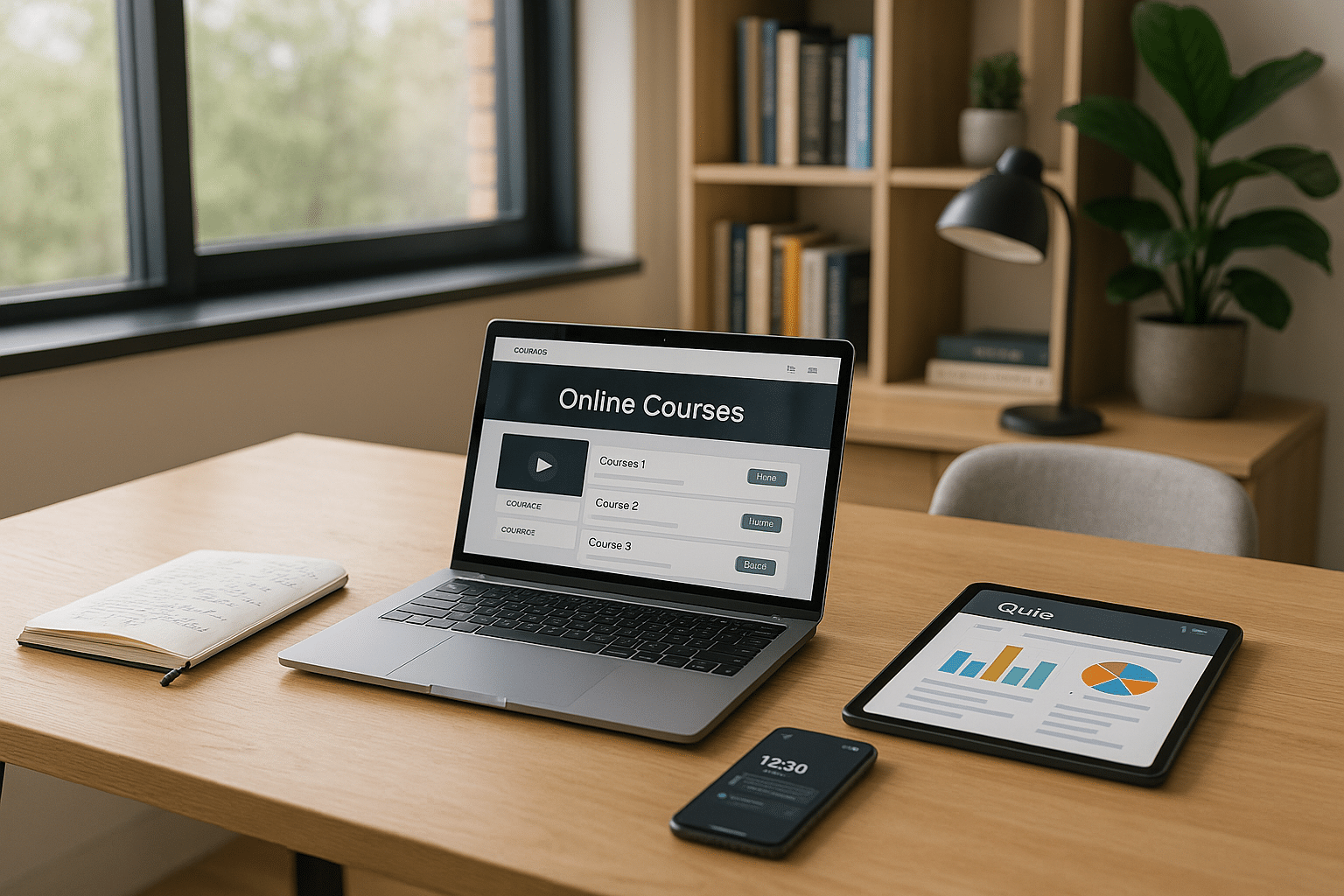Not only has it transformed the way we acquire knowledge, but it has also changed how educators assess their students. Online course assessments have emerged as a critical component of digital education, but they can be daunting for educators to master. This comprehensive guide aims to demystify the process of planning and implementing effective online course assessments, helping educators step up their digital teaching game.
Online course assessments provide a plethora of benefits. They allow educators to measure learning outcomes, monitor student progress, and provide constructive feedback. However, mastering these assessments requires strategic planning and meticulous implementation. When executed correctly, they can significantly enhance the online learning experience for both educators and students.💡
The journey toward mastering online course assessments can be a steep learning curve, especially for those who are new to the virtual learning landscape. Fear not, for this guide will systematically walk you through each stage, making the process less overwhelming and more manageable.💼
What this guide will cover
Ready to dive in? This guide will cover key topics such as:
- The importance of online course assessments in modern education.
- Effective strategies for planning online course assessments.
- Tools and technologies that aid in implementing online assessments.
- Ensuring the integrity of online assessments.
- Engaging students and providing constructive feedback.
With this guide, you will not only understand the essence of online course assessments, but you will also be equipped with practical tips and strategies to carry out effective assessments that will bolster your online teaching skills.⚡
Why you should read this guide
If you are an educator seeking to enhance your digital teaching skills, or an educational institution aiming to improve the quality of your online courses, this guide is for you. It is a blend of theory and practical knowledge, peppered with actionable tips, and rooted in the latest research. Moreover, it provides a roadmap for mastering online course assessments, a skill that is increasingly vital in today’s digital learning landscape.🎯
In essence, this guide is not just about learning the mechanics of online course assessments. It’s about understanding the transformative impact they can have on online education. It’s about realizing the potential of digital tools to create engaging, meaningful, and effective learning experiences. It’s about embracing the future of education and empowering educators and students alike.🌐
Mastering online course assessments is a journey. It’s about adapting, growing, and continuously improving. It’s a skill that requires time, patience, and practice. But the journey is worth it, for the destination is a more efficient, effective, and engaging online learning experience. So, ready to embark on this exciting journey? Let’s get started!🚀
Unfolding the Mystery of Online Course Assessments
There’s no denying that online learning has become a prominent part of our lives, especially during the recent times. With a significant shift towards digital platforms for education, the approach towards course assessments has also been evolving. But are we really leveraging the potential of online course assessments effectively?
As an experienced software engineer and technical writer, I have been closely associated with the online learning ecosystem. Over the years, I have realized that course assessments, when planned and implemented efficiently, can significantly enhance the learning outcome. Therefore, in this article, I aim to provide you with a step-by-step guide to mastering online course assessments. The journey will be filled with essential technical details and engaging practical tips. So, let’s dive in!
Before we proceed, I would highly recommend watching the YouTube video, “Strategies for Creating Online Assessments” by ‘Teaching and Learning Innovation Centre.’ This video provides excellent insights into the development of meaningful and effective online assessments.
Step 1: Defining the Purpose of Assessment
The first and foremost step in the journey towards effective course assessment is defining its purpose. What exactly do you want to achieve with the assessment? Is it to evaluate the learners’ understanding of the course material? Or is it to provide feedback for further learning?
Depending on your purpose, the design and format of the assessment will vary. For instance, if the purpose is to evaluate understanding, a formative assessment method such as quizzes or tests might be more suitable. On the other hand, if the purpose is to provide feedback, a summative assessment method like assignments or projects might be more effective.
Here’s a comparative table that will help you understand the difference between formative and summative assessment methods:
| Assessment Type | Primary Purpose | Examples |
|---|---|---|
| Formative | Evaluate understanding | Quizzes, Tests |
| Summative | Provide feedback | Assignments, Projects |
Step 2: Designing the Assessment
Once you have defined the purpose, the next step is to design the assessment. This involves deciding on the assessment type (multiple-choice, fill in the blanks, essay type, etc.), the scoring mechanism, and the level of difficulty.
A good practice is to align the assessment design with the course objectives. For example, if the course objective is to develop practical skills, then a project-based assessment might be more suitable than a multiple-choice quiz.
Remember, a well-designed assessment should not only test the learners’ knowledge but also encourage critical thinking and problem-solving skills. For more insights on designing online assessments, I would suggest watching the YouTube video, “Designing Online Assessments: Best Practices” by ‘Educause’.
Step 3: Implementing the Assessment
The final step in the process is the implementation of the assessment. This involves setting up the assessment on the online learning platform, providing clear instructions to the learners, and ensuring that the assessment is accessible and user-friendly.
During implementation, it’s also crucial to provide timely feedback to the learners. Feedback not only helps learners understand their mistakes but also motivates them to improve.
Moreover, it’s essential to keep revising and updating the assessment based on the learners’ performance and feedback. For more practical tips on implementing online assessments, watch the YouTube video, “Implementing Online Assessments: Challenges and Solutions” by ‘EduTech’.
Mastering Online Course Assessments: The Road Ahead
Mastering online course assessments is not a one-time task, but a continuous process of learning and improvement. With the rapid advancements in technology, new assessment tools and techniques are emerging, making the process more efficient and effective.
As educators and course creators, it’s our responsibility to stay updated with these trends and continuously improve our assessment practices. So, let’s embark on this journey towards mastering online course assessments, and together, we can make online learning a more enriching and rewarding experience for all.
Remember, every great journey begins with a single step. So, why wait? Start planning your course assessment today!

Conclusion
In the realm of digital evolution, we’ve examined the various facets of emerging technologies, from cloud computing to machine learning, cybersecurity, DevOps, and the Internet of Things (IoT). As we draw this comprehensive review to a close, it’s critical to recap the major points we’ve covered, emphasizing the crucial role of these technologies in our contemporary digital world.
We began our journey with a deep dive into cloud computing, discussing its architecture, benefits, and real-world applications. Cloud computing has grown exponentially, providing organizations with the ability to streamline operations and enhance productivity in a cost-effective manner. It has paved the way for on-demand access to a pool of configurable computing resources, eliminating the need for heavy investments in infrastructure.
Next, we moved into the field of machine learning, a subset of artificial intelligence that allows computers to learn and make decisions without being explicitly programmed. Machine learning is reshaping industries, driving personalized customer experiences, and enabling data-driven decisions.
Our discussion then shifted to cybersecurity, a critical issue in the digital age. With the increasing number of cyber threats, the need for robust security measures has never been more important. We explored different cybersecurity strategies, highlighting the importance of proactivity and responsiveness in safeguarding digital assets.
The spotlight then fell on DevOps, a software development methodology that bridges the gap between development and operations teams. DevOps promotes a culture of collaboration, enabling faster software delivery and high-quality output. It’s a pivotal approach in the current digital scenario, where continuous delivery and agility are the need of the hour.
Last but not least, we delved into the Internet of Things, a network of interconnected devices that communicate and exchange data with each other. IoT is revolutionizing our lives, changing the way we work, live, and play.
The digital transformation journey is challenging, but it’s also filled with exciting opportunities. The aforementioned technologies are not standalone entities; they intertwine and reinforce each other, creating a powerful ecosystem that fuels innovation and growth.
Each of these elements – cloud computing, machine learning, cybersecurity, DevOps, and IoT – contribute to the larger picture of digital evolution. As we continue to explore and embrace these technologies, we are inching closer to a more connected, efficient, and secure digital world.
As we conclude this review, I invite you to reflect on these discussions, share your thoughts, and engage with the community. Let’s continue the conversation, deepen our understanding, and explore new ways to apply what we’ve learned. Remember, our collective knowledge is our greatest tool for navigating the digital landscape. 🌐💡🚀
Stay tuned for more in-depth articles and feel free to drop any questions, suggestions, or experiences you might have in the comment section. Let’s keep the ball rolling on this exciting journey towards digital evolution! 🔍🗨️🔄
And before I sign off, here are some useful resources to dive deeper into the topics we discussed: [Cloud Computing](https://www.ibm.com/cloud/learn/cloud-computing), [Machine Learning](https://www.microsoft.com/en-us/research/research-area/machine-learning/), [Cybersecurity](https://us-cert.cisa.gov/), [DevOps](https://www.atlassian.com/devops), and [Internet of Things](https://www.iotforall.com/what-is-iot-simple-explanation). Happy learning!
Let’s gear up for a more digitized tomorrow! 🚀



